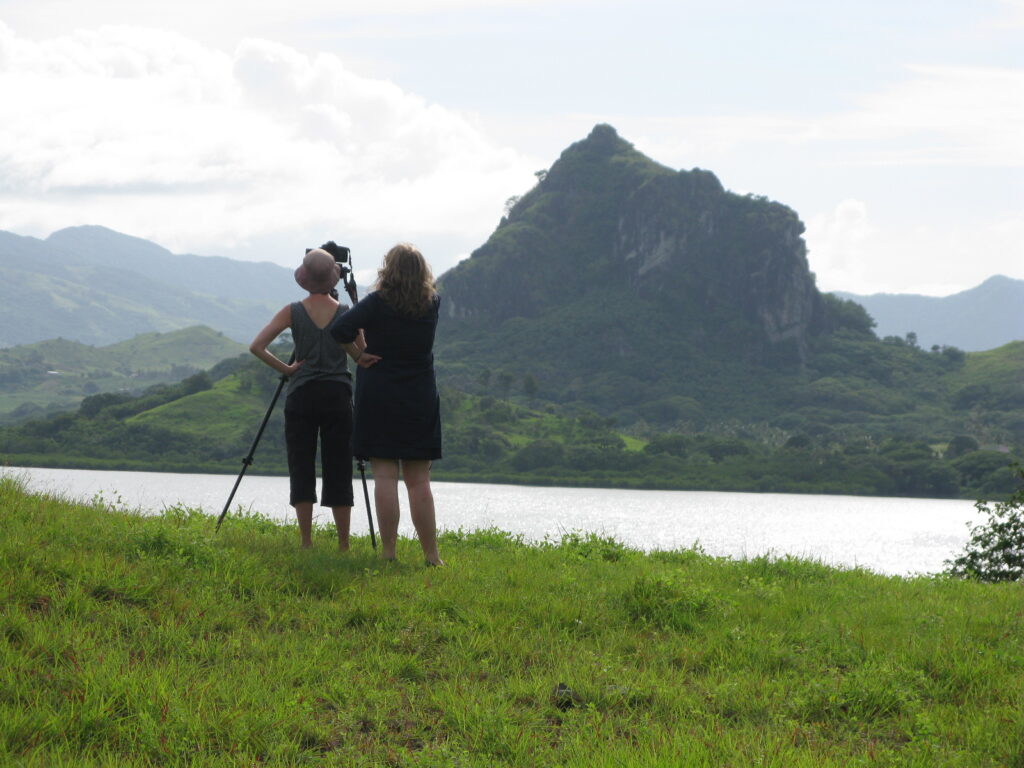When we left off at the end of the last blog we had arrived on the Sigatoka River at the Nasau Vocational Centre on the site of G.H.’s former land, where we enlisted a young construction trainee, Napolioni into the acting corps. We had our location and cast for the reenactment.

The first time we shot this scene in the U.S., we shot it very simply, with two actors, a bamboo stick, and a rifle. But when we decided to reshoot it, we wanted to be more accurate to the original event. When we reviewed the original trial transcript of what happened in 1879 we realized that we needed to shoot the scene with a more complex (and intense) fight sequence. The scene required that Enoki and Pitir come down the river bank, they start spear fishing, G.H. comes out to the top of bank and yells at them to get off his land, Enoki protests, G.H comes down and tries to hit Enoki with a bamboo stick, Enoki grabs the stick and flings it away, G.H grabs a second stick and swings at Enoki, Enoki is hit and then grabs the stick from G.H and hits G.H. back, G.H falls and grimaces in pain, an enraged G.H. tries to grab Pitir’s fishing spear, Pitir refuses to let go of the spear, G.H. steps back and pulls out his belt knife, Pitir and Enoki flee by land and sea, G.H. goes to get his rifle, comes back and shots a swimming Enoki, who dives into the water when the shot is fired, possibly hit or not hit by the G.H.’s bullet.

Sounds simple, right? Well maybe if you are John Woo or at least have John Woo’s fight choreographer on the set. Not so easy for a small crew of documentary filmmakers! Filipe and I focused on fighting with maximum fierceness while at the same time not hurting each other (which we mostly managed!). The muddy river bottom was like quicksand and Filipe sank into the mud as we fought. Meanwhile, a crowd of young Fijian trainees from the vocational centre gathered at the top of the riverbank to watch the shoot. We had an audience! As the afternoon wore on, Alexi and Smith brought their talents out to get every shot of the complex sequence before we ran out of light or film. We think we pulled it off, but we won’t know for sure until we get back to the States and develop the film!

The next day, we came back to the Sigatoka River to shoot an interview with Joveci Nakubu, whose family has lived near what (we hoped) was G.H.’s former land for generations. We brought Jean along and filmed her meeting with Jo. Jean brought Jo a “waka”, a bunch of yaqona root for making cava that is given as a traditional gift in Fiji. Jo welcomed Jean with open arms and they sat together for the camera to discuss each of their family’s history on the Sigatoka River.

Jean retold G.H.’s history coming to Fiji during the Cotton Rush of the 1860′s and coming to Sigatoka to try to make a living as a planter. She recounted the shooting of Enoki and G.H.’s going to jail for the crime. Joveci explained to Jean that his family land used to be a Fijian village, and that Enoki must have been a teacher to his ancestors who lived there. Jo told Jean that when he heard about the story (from us three weeks previously) he was very interested and decided to do his own research. He brought out documents that confirmed that G.H. Lee’s plantation was adjacent to Jo’s village. Jean and Jo had an interesting discussion about what those early colonial days must have been like for each of their families.
Then Jo accompanied Jean to the Nasau Vocational Centre next door so she could she the scene of the crime herself. Unfortunately, the terrain was too rough and the bank was too steep for Jean to get down to the river. Only one solution! Anton and I had to carry Jean down the riverback!. Later, we interviewed Joveci on his own, and it was very interesting.

The next day was meant to be a day off for our crew, but unluckily for them, we had another amazing Fijian coincidence to document and interesting subject to interview. You see, I was intrigued by Anna Mohammed, the elderly owner of the Waitaci Villas where we were staying. Anna lives in the large house next to the small A-frame villas that she rents out. I asked some questions to her and her lovely daughter Maureen, and I found out that she is of mixed European and Fijian background, and that she had married an Indo-Fijian at a time when that kind of mixed marriage was uncommon. This was interesting enough, but then they told me about Anna’s great-(great?) grandfather Ezra Walker Works, an American who had come to Fiji in the mid-19th century. When I heard the name, I realized that it was the same name that was on the documents that Jo had showed me, and that Works was one of the men who had leased the land to Jean’s grandfather G.H. all those years ago. For the last coincidence, we found out that Anna is the grandmother of Jason Tutani, the young director of the Sigatoka Sand Dunes who we had interviewed only two days previously (See Blog 3.3 below). Of course, we should not have been surprised, as being in Fiji is experiencing one coincidence after another. It really is a very small and interconnected world here. Anyway, we spent the morning of our “day off” interviewing Anna and her lovely daughter Maureen. Then, thankfully, our crew had the rest of the day off to enjoy Fiji without thinking about the film for a few hours….

